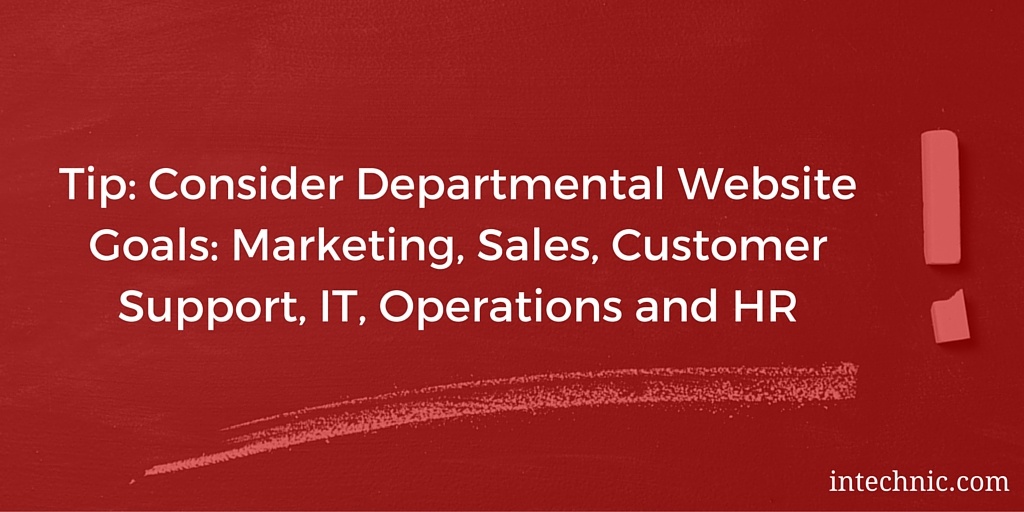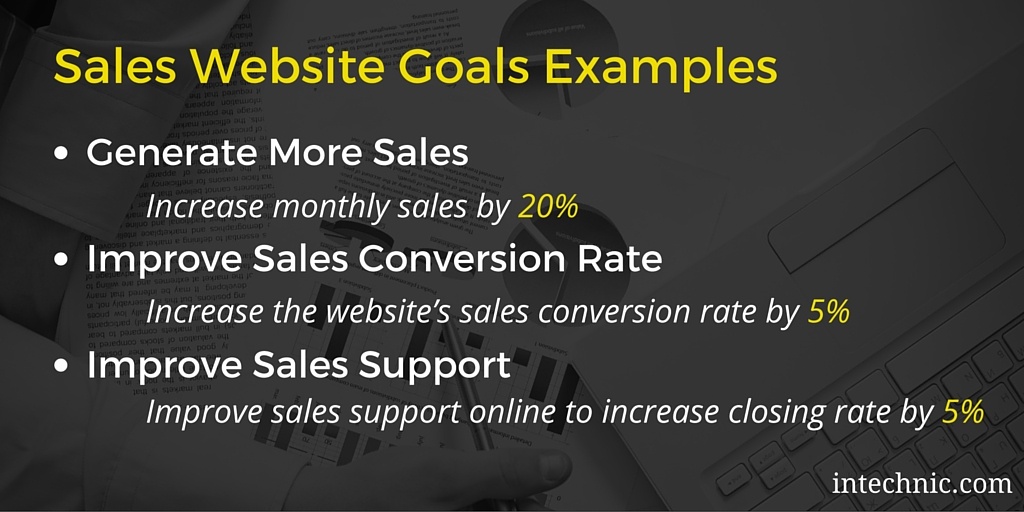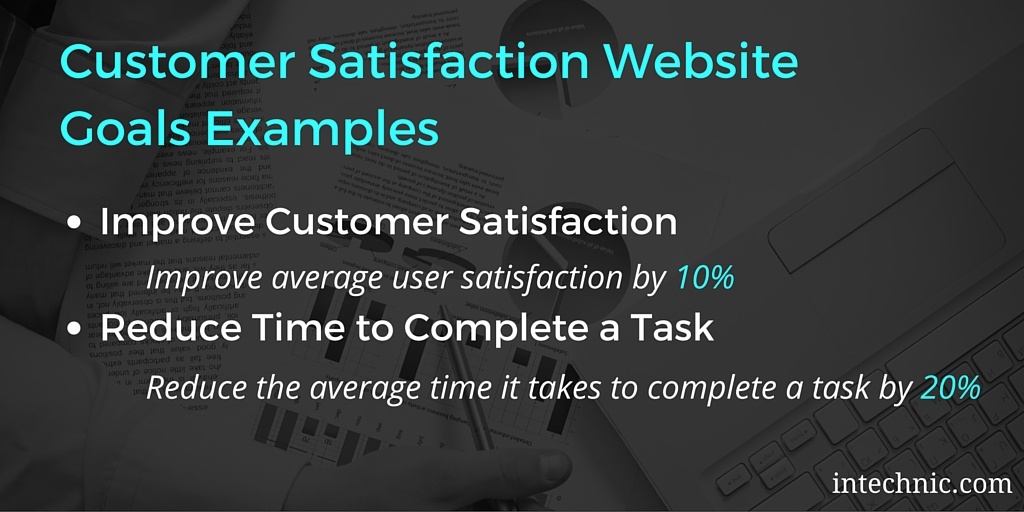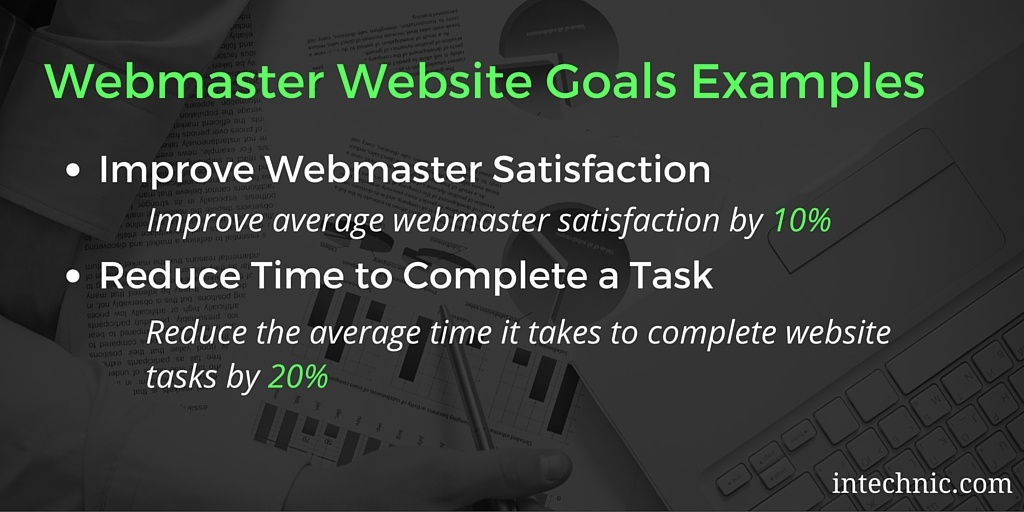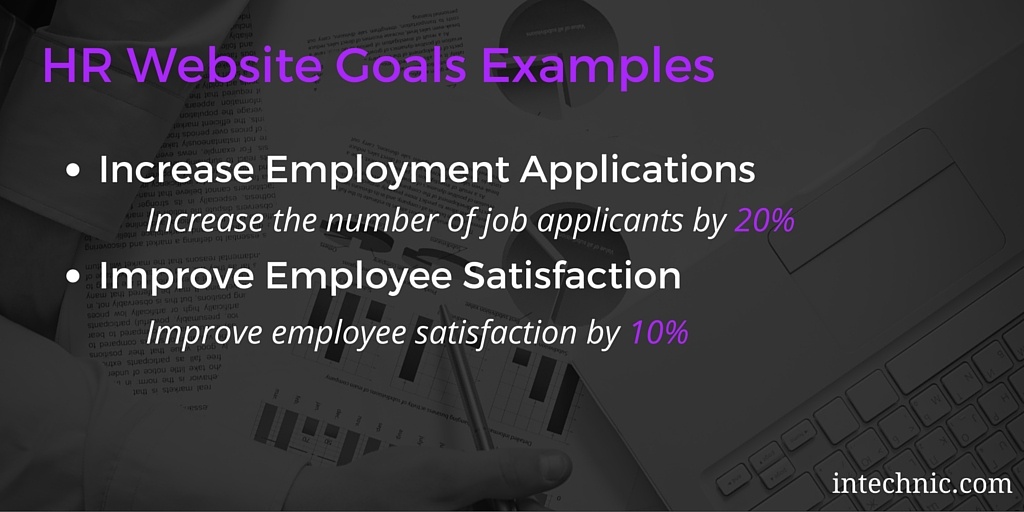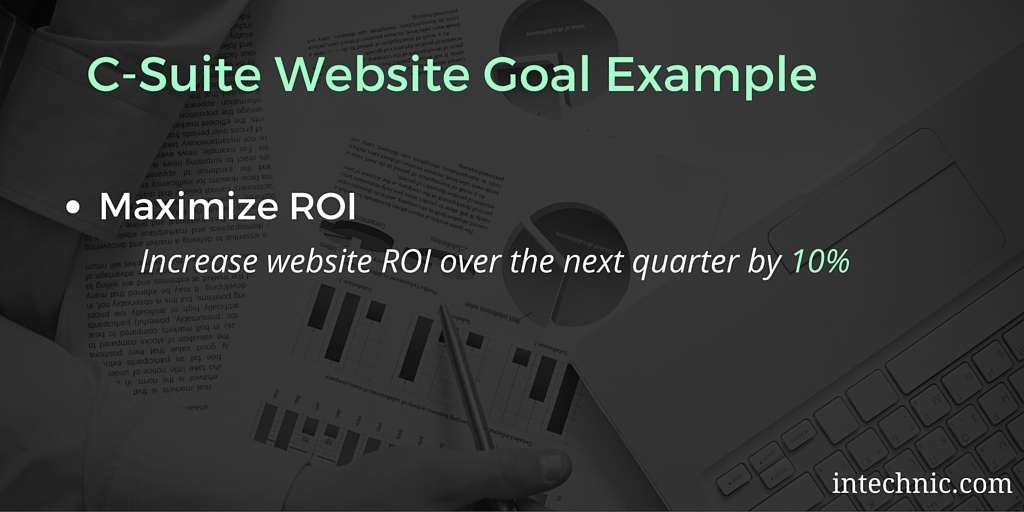Best Examples of Website Goals and Objectives
 Saying “we want a better website” is like saying, “we want a better business”. But what exactly does “a better business” mean? Do you want to increase revenue? Maximize profitability? Or maybe improve customer satisfaction? This could mean a number of different things for different people in different situations. Unfortunately, simply wanting a better website is not a clear objective and many professionals end up learning the hard way that solely stating so won’t correlate to business results.
Saying “we want a better website” is like saying, “we want a better business”. But what exactly does “a better business” mean? Do you want to increase revenue? Maximize profitability? Or maybe improve customer satisfaction? This could mean a number of different things for different people in different situations. Unfortunately, simply wanting a better website is not a clear objective and many professionals end up learning the hard way that solely stating so won’t correlate to business results.
Are Your Goals SMART?
In my article, How to set SMART Website Goals to Reach Business Objectives, I advocate the use of the SMART model for setting Specific, Measurable, Attainable, Relevant, and Timely goals. Good executives manage by numbers. Websites should be no exception (check out UX Statistics you should know). There must be clarity in your website goals and concrete desired business results, or it will fail.
SMART Goal Examples
Now that you know the benefits of SMART website objectives, let’s look at some of the most common website objectives for specific departments. Remember to apply the SMART model to any and all goals. To give you a jumping off point, I’ve prepared a free worksheet with many common goals using the SMART model: Here are SMART website goals by department with a quick recap of their common needs:
- Marketing– drive traffic, engage prospects, generate leads and re-engage existing customers
- Sales– help close sales by validating and supporting sales team communications
- Customer Support – improve customer satisfaction through better service
- Webmasters– simplify and optimize content updates and website management
- IT– integrate with other systems; meet security, performance and scalability requirements
- Operations– reduce costs by streamlining and automating workflows and tasks
- HR– attract and recruit new employees and support current employees
- C-Suite – grow the company’s bottom line and increase profitability
Marketing Website Goals
Marketing departments typically want the company website to attract and engage more prospects, generate more leads, better support the company brand or raise awareness. Some common marketing website goals include:
1. Generate More Qualified Leads
This is arguably the most popular goal for business websites that have lead generation as their main purpose. This goal is best for companies that want to get more sales leads through improving their website’s marketing performance. To measure lead increase, I recommend setting a percentage rate increase as opposed to an absolute lead count. This accounts for monthly traffic fluctuations and allows for meaningful historical comparisons. Also, make sure to track qualified leads versus total general leads and set specifications as to what is considered a qualified lead. Doing so will also measure the quality of leads you are getting. Example: Increase the number of monthly qualified leads by 20% (qualified lead: decision maker; headquartered in the U.S., revenue of $10M+).
2. Improve Lead Conversion Rate
This measures the ability of a website to capture information of a visitor and convert them into a prospect (measured as a percentage of website visitors who become prospects). This goal is good for companies that want to focus on the website’s ability to convert and is a great goal to set for inbound (content) marketing campaigns. This goal can also help measure changes in the quality of traffic. For this type of goal, it is crucial to know your website’s current conversion rate. This way, you can determine a realistic percentage increase. Example: Increase the website’s conversion rate by 5% (with the same amount of traffic).
3. Increase Awareness
This goal lends to measuring how effective your website is in educating users about your new products or services when you are not necessarily “selling” online. This works well for websites that serve an informational purpose but don’t necessarily need to generate leads or capture information, such as: micro-sites for new product launches, political and government websites or non-profit websites dedicated to raising awareness around a certain cause. The only reliable way to measure this goal is by surveying users before and after a redesign on how well they understand the new product or service (brands) or cause (non-profits). Example: Improve new product awareness by 10% (measured by surveying before and after). Marketing website goals worksheet and examples 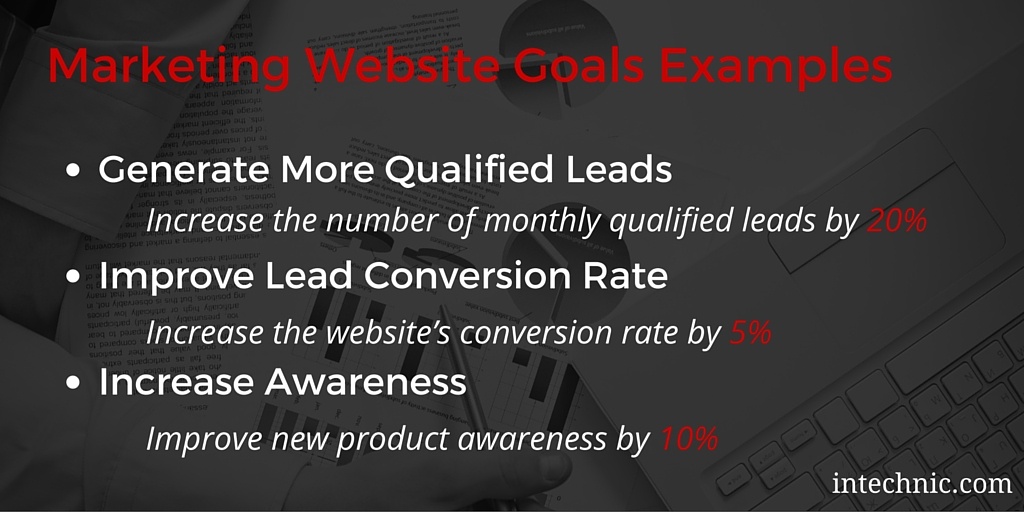
Sales Website Goals
E-commerce and SaaS websites typically (and rightfully) focus on maximizing direct sales. Conversely, sales departments in companies that don’t sell directly to their customers online typically want their company website to support the communications of the sales team throughout the sales process. Therefore, some common sales website objectives include:
4. Generate More Sales
This is the most popular goal for e-commerce websites that sell products or services online (SaaS also falls into this category) and is best for companies that want to maximize their online sales. Similar to lead increase goals, I recommend setting a percentage rate increase (in %) as opposed to an absolute sales amount. This will account for seasonal sales fluctuations and will allow for more meaningful historical comparisons. Example: Increase monthly sales by 20%.
5. Improve Sales Conversion Rate
Similar to marketing, this goal measures the ability of a website to sell (convert a website visitor into a customer). It is typically measured as a percentage of website visitors who become paying customers. This goal is suited best for e-commerce/SaaS websites that want to focus specifically on maximizing a website’s ability to sell. This goal can also help measure changes in the quality of traffic. Just as with marketing KPIs, it is absolutely crucial to know your website’s current conversion rates before setting this goal. Example: Increase the website’s conversion rate by 5% (with the same amount of traffic).
6. Improve Sales Support
If the role of your website is to help validate and support communications of the sales team throughout the sales process, this could be a good goal to set. It can be tricky to measure if the website’s primary role is not to generate leads but instead to help validate and support the leads generated offline by the sales team. I recommend a combination quantitative/qualitative goal. Survey your sales team to see if the new website better supports them and review sales KPIs: closing rate, time to close, etc. Example: Improve sales support online by featuring relevant case studies and testimonials on the new website. Prospects visiting the website will see messages consistent with those delivered by the sales team (validating what the sales team says). This should result in a closing rate increase of 5% (measured through CRM before and after website redesign). Sales website objectives worksheet and examples
Customer Satisfaction Website Goals
If your website provides a support role for your existing customers, then improving customer satisfaction through better user experience and service, along with reducing the time it takes to complete certain tasks, might be good customer satisfaction objectives for your website:
7. Improve Customer Satisfaction
Measuring online customer satisfaction is tricky business but if your website’s objective is to improve customer satisfaction through user experience, then you should consider qualitative research in the form of surveying your customers before and after a redesign. This type of goal is ideal for websites that serve a support function for existing customers (SaaS and online customer accounts), members (member portals), patients (healthcare), etc. For example: medical patients don’t enjoy spending time on hospital websites. They want to be in and out when making appointments, accessing test results or paying a bill before going on their way. Ease of use is vital and so interviewing/surveying patients (in this case) before and after the website’s redesign is important to determine what their needs are and if the new website provides for a better experience. Example: Improve average user (customer/member/patient) satisfaction by 10% (measured using surveys before and after redesign).
8. Reduce Time to Complete a Task
Similar to the previous goal, a more quantitative way to measure customer satisfaction is to look at the time it takes to complete certain tasks on the website. Let’s face it, nobody likes to see their time wasted. Continuing with the previous example, a medical patient who can spend less time on a hospital website, making appointments and paying bills, is more likely to report a better user experience. Therefore it stands to reason that, the less time it takes to complete this task, the happier your customers will become. If your website has a particular function that your users access a lot( a certain feature, access to information, registration, bill pay, etc.), you can set a goal of reducing the time it will take to complete that action. You can then measure the time it takes using various usability testing tools or events in Google Analytics. Example: Reduce the average time it takes to complete a task by 20% (measured through usability testing or analytics). Customer Support objectives worksheet and examples
Webmaster / Content Contributor Goals
Webmasters and content contributors are typically the first line of defense for your company website. They are typically in charge of the upkeep: managing functions and keeping the content up to date. They rely on Content Management Systems (CMS) and various other website management tools to do their job. Most of them would agree with setting the following objectives for a redesign:
9. Improve Webmaster / Content Contributor Satisfaction
Similar to improving the satisfaction of customers, your webmasters and content contributors must also be happy. They should have all the tools they need to do their job effectively and efficiently. If they are doing redundant or duplicate work, rely on workarounds or they are unable to perform websites updates, improving their satisfaction should be a goal. They should be interviewed/surveyed before and after the website’s redesign to determine what their needs are and if the new website provides for a better experience. Example: Improve average webmaster/content contributor satisfaction by 10% (measured using surveys before and after redesign).
10. Reduce Time to Complete a Task
Just like reducing the time spent on tasks by customers, you can apply the same qualitative approach to measuring the time it takes to perform certain management or content updating tasks by webmasters or contributors. Saving their time directly results in cost reductions for the organization. You can measure the time it takes to complete these tasks using usability testing tools or events in Google Analytics. Example: Reduce the average time it takes to complete website tasks by 20% (measured through usability testing or analytics). Webmaster / Content Contributor goals worksheet and examples
IT Website Goals
IT departments often provide a support role for your website and, if a problem occurs, they may have to step in. Websites that are cumbersome to maintain, don’t mesh well with other technology, pose security risks or constantly go offline represent liability and additional cost to your IT department. Most IT departments would agree on the following IT website objectives:
11. Reduce Website Management Costs
This goal can measure the reduction in time (and money) spent on running, supporting and maintaining a website. It can be measured in man-hours as well as in dollars. This is a good goal for a company that is spending an exorbitant amount of money on support and maintenance of their website due to outdated technology, incompatibility with other systems, frequent downtimes, security flaws or other performance issues. Example: Reduce website support/maintenance costs by 10% (measured in dollars and employee hours) by deploying CMS designed for efficient content updates. IT website objectives worksheet and examples
Operations / Production Goals
Common website goals for Operations and Production departments are to use their company website to optimize and streamline workflows and to automate tasks. This could result in improved customer/employee satisfaction as well as reduced costs (both methods can be used, depending on the goal).
12. Optimize Workflow Automation
Another way of saving money using the website is through optimizing the flow of information, automating various tasks and reducing overhead by integrating the website into your company’s IT ecosystem. This can be achieved by integrating your website with other systems: marketing automation, CRM, accounting software, customer support systems, applicant tracking system, process and project management, document and asset management, inventory management, fulfillment and production automation, and the list goes on. Example: Reduce support costs by 15% by rolling out online customer support on the website, consequently reducing the number of phone calls taken by the support team. Operations goals worksheet and examples
HR Website Goals
Common website goals for Human Resources are often set to help attract and recruit new employees as well as to help support current employees:
13. Increase Employment Applications
This goal looks at the number of job applications submitted through the website. This is a good goal for companies that prioritize attracting new talent and want to advertise job openings as well as encourage online applications. This can be measured with the help of an ATS (applicant tracking system). Similar to leads, I recommend setting the goal as a percentage rate increase. Example: Increase the number of job applicants by 20%.
14. Improve Employee Satisfaction
If one of your website’s objectives is to help support your employees (training, employee portal, collaboration tools, company social network), then employee satisfaction can be a good metric to track. Just as with customers, measuring employee satisfaction is a tricky business. Consider surveying your employees before and after your website redesign. For a more quantitative approach, consider measuring the number of times the tools are used (engagement rates). Example: Improve employee satisfaction by 10% (measured by surveying before and after). HR goals worksheet and examples
C-Suite Website Goals
So far we’ve been focusing on common departmental website goals and what’s important to marketing, sales, customer support, IT and HR. But what about looking at the company as a whole? What does executive management want to see from the new website? Website can be a significant investment that often requires the approval of a CEO and/or a CFO. How do you justify a redesign to your CEO/CFO? Or, if you are a CEO, how do you make a decision whether or not the website is a good investment?
15. Maximize ROI
The answer is simple: ROI. You need to be able to demonstrate the Return on Investment. That’s the #1 consideration for any CEO or CFO. How will the new website contribute to the bottom line? Note that every goal example in this article directly impacts the company’s bottom line. The first step in determining ROI is by establishing departmental website goals. You can then evaluate how these changes will positively impact the company as a whole and present this information to your CEO/CFO.
Setting SMART website goals is an important step in any website redesign. Make sure you know exactly what you want to achieve with your website before diving into a project that could take months to complete. 


